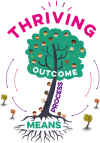What factors influence thriving in adolescent and young adult cancer patients? A focus on psychological health, biological markers, and quality of life
- PMID: 40181483
- PMCID: PMC11969851
- DOI: 10.1186/s40359-025-02637-9
What factors influence thriving in adolescent and young adult cancer patients? A focus on psychological health, biological markers, and quality of life
Abstract
Purpose: This study explores the role of psychological health, biological markers, and quality of life (QoL) in influencing thriving - defined as resilience and enhanced well-being - among adolescent and young adult (AYA) cancer patients.
Methods: A total of 148 AYA cancer patients were assessed for psychological health indicators (anxiety, depression, character strengths), physiological markers (cortisol awakening response [CAR], melatonin), and QoL. Thriving levels were evaluated using ordinary least squares regression and quantile regression to identify predictors across different thriving percentiles.
Results: Psychological health was the strongest predictor of thriving. Depression negatively impacted thriving at lower levels, while inquisitiveness consistently enhanced it. CAR and melatonin played roles at higher and median thriving levels, respectively, and QoL was most influential at lower levels. These factors collectively explained 23.0% of the variance in thriving scores.
Conclusions: This study highlights depression, inquisitiveness, CAR, and QoL as key factors influencing thriving in AYA cancer patients. Depression affects thriving at lower levels, inquisitiveness enhances thriving consistently, CAR is significant at higher levels, and QoL is crucial at lower levels. These findings underscore the need for tailored interventions to support thriving across varying levels of adaptation.
Keywords: Adolescent and young adult; Biomarker; Psychological health; Quality of life; Thriving.
© 2025. The Author(s).
Conflict of interest statement
Declarations. Ethics approval and consent to participate: Adherence to the Declaration of Helsinki’s guidelines was ensured in this research, with ethical clearance granted by the Institutional Review Board (IRB) of the Third Xiangya Hospital, Central South University (Approval No. 2020-S063). All study participants provided informed consent prior to their inclusion in the research. For participants under the age of 16, informed consent was obtained from their parents or legal guardians, in accordance with ethical guidelines. Consent for publication: Not applicable. Competing interests: The authors declare no competing interests.
Figures


Similar articles
-
A longitudinal study of the profiles of psychological thriving, resilience, and loss in people with inflammatory bowel disease.Br J Health Psychol. 2017 Nov;22(4):920-939. doi: 10.1111/bjhp.12262. Epub 2017 Aug 14. Br J Health Psychol. 2017. PMID: 28804983
-
Prevalence and risk of psychological distress, anxiety and depression in adolescent and young adult (AYA) cancer survivors: A systematic review and meta-analysis.Cancer Med. 2023 Sep;12(17):18354-18367. doi: 10.1002/cam4.6435. Epub 2023 Aug 10. Cancer Med. 2023. PMID: 37559504 Free PMC article.
-
Adolescent and young adult cancer survivors' memory and future thinking processes place them at risk for poor mental health.Psychooncology. 2018 Dec;27(12):2709-2716. doi: 10.1002/pon.4856. Epub 2018 Sep 30. Psychooncology. 2018. PMID: 30109738
-
Subjective memory complaints in young people: the role of resilience.Psychol Health. 2024 Sep;39(9):1243-1262. doi: 10.1080/08870446.2022.2141240. Epub 2022 Nov 11. Psychol Health. 2024. PMID: 36368933
-
Factors related to the resilience and mental health of adult cancer patients: a systematic review.Support Care Cancer. 2021 Jul;29(7):3471-3486. doi: 10.1007/s00520-020-05943-7. Epub 2021 Jan 29. Support Care Cancer. 2021. PMID: 33512578
References
-
- National Comprehensive Cancer Network. NCCN guidelines for patients adolescent and young adult cancer 2023 [cited 2024 08/29]. Available from: https://www.nccn.org/patients/guidelines/content/PDF/aya-patient.pdf
-
- Cho E, Docherty SL. Beyond resilience: A concept analysis of human flourishing in adolescents and young adults with cancer. ANS Adv Nurs Sci. 2020;43(2):172–89. 10.1097/ans.0000000000000292. - PubMed
-
- Brown DJ, Arnold R, Fletcher D, Standage M. Human thriving. Eur Psychol. 2017;22(3):167–79. 10.1027/1016-9040/a000294.
-
- Fabian M, Alexandrova A, Nair YC. Coproducing wellbeing policy: A theory of thriving in financial hardship. J Happiness Stud. 2023;24(7):2309–30. 10.1007/s10902-023-00682-y.
MeSH terms
Substances
Grants and funding
LinkOut - more resources
Full Text Sources
Medical

